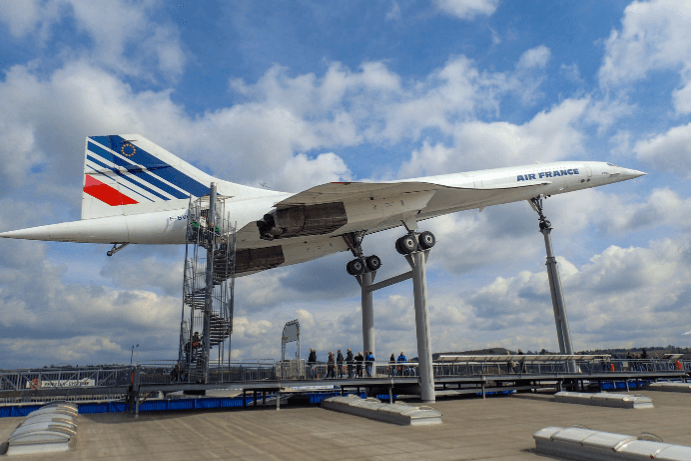On March 2, 1969, the aviation world witnessed a gigantic leap forward as the Concorde 001 prototype launched on its maiden flight from Toulouse, France. This event marked the beginning of supersonic passenger travel and forever altered the landscape of commercial aviation.
The 1950s and 1960s were characterized by rapid technological developments. And those were the golden old days with a passionate desire to shrink the world through faster travel. Amid this backdrop, British and French aerospace engineers embarked on an ambitious project to develop a supersonic airliner. This collaboration culminated in the signing of an Anglo-French treaty on November 29, 1962. This program led to the birth of Concorde and the cost was estimated at £70 million.
The Maiden Voyage: Concorde 001 Prototype
Historic day: On March 02, 1969, test pilot Andre Edouard Turcat took control of the Concorde 001 Prototype. The aircraft gracefully ascended from Toulouse-Blagnac Airport and marked the beginning of a new era in aviation. The inaugural flight lasted 27 minutes, during which Concorde demonstrated its potential to revolutionize air travel. It achieved speeds that would halve transatlantic journey times.
The Concorde 001 was not just about speed; it was a testament to human creativity and engineering prowess. With a maximum cruising speed of 2,179 km/h (1,354 mph), or Mach 2.04, it could fly faster than twice the speed of sound. This capability allowed passengers to travel from London to New York in approximately three hours.
However, commercial flights commenced on January 21, 1976. The routes extended from London to Bahrain and Paris to Rio de Janeiro. Over its operational lifespan, more than 2.5 million passengers experienced the thrill of supersonic travel aboard Concorde. Each journey was not just a flight but a statement of luxury and technological advancement.
Concorde : A Supersonic Design
The Concorde’s design was a groundbreaking fusion of aerodynamics. Its drooping nose, and ogival delta wing—a double-delta or ogee planform—allowed for optimal aerodynamic efficiency at supersonic speeds, reducing drag and enhancing lift.
Concorde 001 was a tailless aircraft design with a narrow aircraft body permitting 4-abreast seating for up to 128 passengers. This tailless configuration, shared by a few aircraft like the Tupolev Tu-144, contributed to its sleek profile and performance.
This supersonic aircraft was powered by four Rolls-Royce/Snecma Olympus 593 turbojets with variable engine intake ramps, and reheat for take-off and acceleration to supersonic speed. The airframe predominantly utilized a high-temperature aluminum alloy. It balanced the need for structural integrity with weight considerations, essential for achieving and sustaining Mach 2.02 cruising speeds.
Concorde’s fly-by-wire flight-control system, an analog precursor to modern digital systems, marked a pioneering step in aviation. It provided pilots with precise handling characteristics. The integration of a variable engine air intake ramp system, managed by digital computers, ensured optimal airflow to the engines across varying speeds and altitudes.
Additionally, the aircraft’s supercruise capability enabled it to maintain supersonic travel without the continuous use of afterburners, distinguishing it from military jets of the era.
Concorde Engine: Olympus 593
The Concorde’s incredible speed and efficiency were made possible by its Rolls-Royce/Snecma Olympus 593 turbojet engines. These were among the most advanced and powerful jet engines ever developed for commercial aviation. Each engine was capable of producing 38,050 pounds of thrust with afterburners. The engines featured afterburners, typically found in military jets, which injected fuel into the exhaust stream to provide an extra boost. Afterburners were primarily used during takeoff and acceleration through the sound barrier, enabling Concorde to reach Mach 1 and beyond.
Concorde flew in the stratosphere, where air resistance is lower. The Olympus 593 engines were optimized for high-altitude performance, making Concorde incredibly fuel-efficient at cruising speeds despite its high fuel consumption during takeoff.
Concorde’s engines were one of the loudest ever used on a commercial aircraft, leading to noise restrictions in many airports. The heat generated by supersonic flight made the aircraft’s skin reach 127°C (260°F), requiring specialized materials to handle the extreme conditions.
Although Concorde was retired in 2003, its engines remain an engineering marvel, and their design principles continue to influence modern aviation innovations
Conclusion
Today – March 02, as we celebrate the anniversary of the Concorde 001 Prototype, we are reminded of its significant contributions to aviation history. The aircraft not only set new standards for speed and design but also inspired future generations to push the boundaries of what is possible.
The story of Concorde is a compelling narrative of innovation, collaboration, and the relentless pursuit of progress. Its legacy continues to influence modern aviation. It serves as a benchmark for speed, elegance, and the unyielding human spirit to explore new frontiers.

